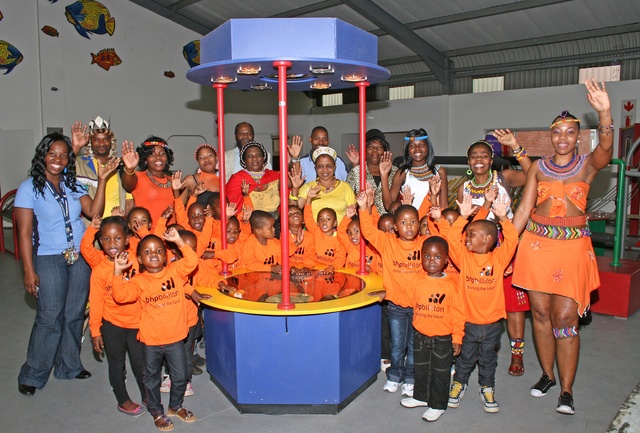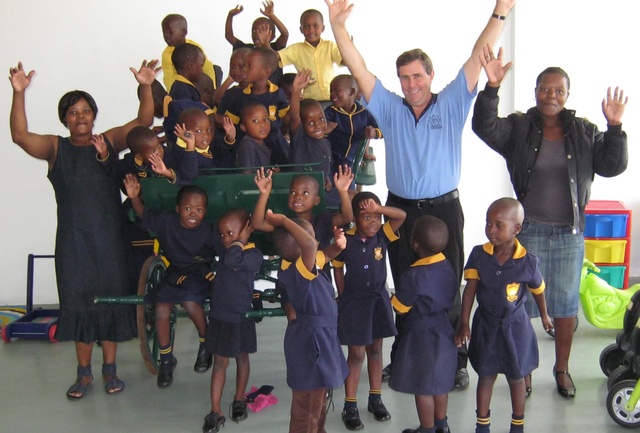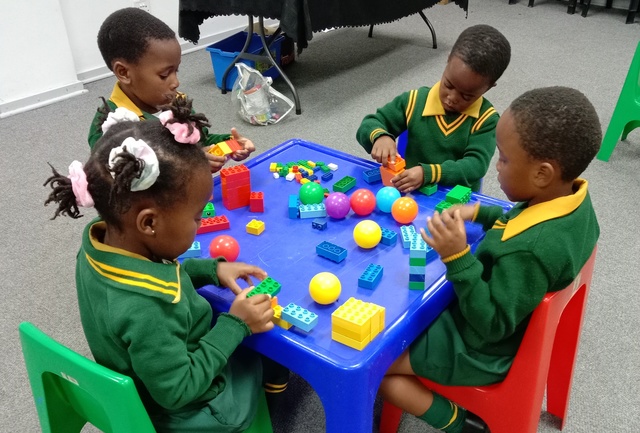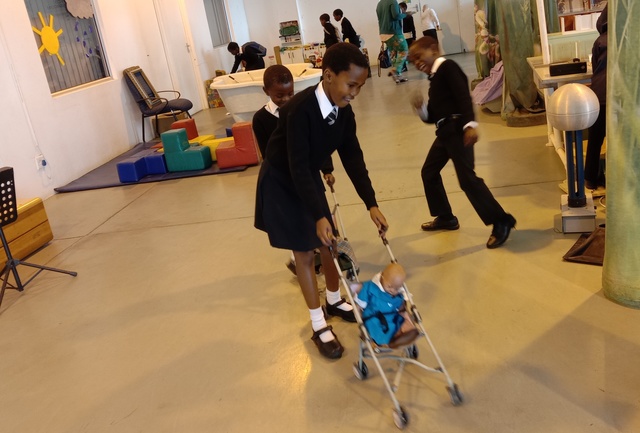
400 million reasons – ECD in Africa
Von:
Derek Fish (Director, Unizulu Science Centre), Silindile Mthembu (ECD leader, Unizulu Science Centre), Richards Bay
Children’s museums are vital institutions that provide exhibits and programmes to stimulate informal learning for children and especially curiosity. In contrast to traditional museums that typically have a hands-off policy regarding exhibits, children's museums feature interactive exhibits that are designed to be manipulated by children. There are many children’s museums in the world, with Hands On! International listing almost 100 on their books and the Association of Children’s Museums almost 500. There are very few in Africa, especially in South Africa.
And yet Africa is the youngest continent on Earth, with some countries having a median age below 16 years old! Over 400 million children now live on the African continent – and the number is increasing. The United Nations estimates Africa's population will double to 2.4 billion by 2050, which will be 25% of the world's population. This means that 40% percent of all children under the age of five would live in Africa by the middle of the 21st century. African children face desperate problems: poverty, hunger, wars and violence, disease, lack of water and basic services. Education is especially critical: 20% of children who should be in primary school are not. Between the ages of 15 and 17, that figure rises to 60%!
Despite South Africa having the strongest economy in Africa, our children face very severe challenges not unlike those to the north of us. The recent PIRLS study indicated that 80% of our Grade 4 children (10-year-olds) are unable to understand what they are reading in their mother-tongue. Our Grade 4 Science and Maths education has consistently been rated last of those surveyed in the TIMSS studies over the last 25 years. Families have been decimated by HIV/Aids and it is estimated that there are a million Aids orphans in South Africa. Even where parents are present, they are very often unable to stimulate early childhood learning, lacking the education and resources to do so.
Where there are severe challenges, there is also great opportunity: Unizulu Science Centre (in Richards Bay, South Africa) is one of the oldest South African science centres, having opened in 1986. It seeks to promote STEM education in the most populous province of KwaZulu Natal. Ninety five percent (95%) of children who visit this centre are from previously disadvantaged rural areas (villages). Cognoscent of James Heckman’s finding that the highest rate of economic returns comes from early investment in children, Unizulu Science Centre opened the first dedicated children’s museum in Africa. The 600-square-meter facility, housing national and international interactive exhibits, was launched in 2011 and has been operating ever since. A generous donation of exhibits from Frida and Fred Children’s Museum in Graz, Austria, provided the bulk of the items on display. Children attend in school groups from their early learning centres, rather than in family groups which is common in Europe.
Statistics published by the South African Department of Education show that in South Africa, 1.6 million children (72%) under 6 years old are enrolled to attend an Early Learning Programme meant to prepare them for school. Concerningly, this figure was closer to 2 million before the COVID-19 pandemic. This shows that there has been a decline in that number because parents are slow to send their children back to pre-school, possibly due to financial strain (many lost their jobs during the pandemic), or because many parents don’t realise how crucial early education is for their child’s future success (according to the Department). This poses a major challenge to the future of children and that of the country. This has severe long-term implications for their education, employment, and income expectations.
It is our wish as Unizulu Science Centre to see transformation in early childhood service delivery in South Africa, particularly to address critical gaps and to ensure the provision of a comprehensive, universally available, and equitable early childhood development service. This can only succeed through collaborations with other global museums offering similar services and working towards achieving similar goals. Nelson Mandela said that “Education is the most powerful weapon you can use to change the world.” Museums are ideal spaces for young children to learn, allowing them to explore their interests through authentic shows, hands-on exhibits, and other activities.
A child’s early years are a critically important time when they are developing key academic, social, and cognitive skills that will determine success later in life. Museums are there to nurture and support this success. Young children are critical to ensuring the future of our museums. Museum-going habits that are formed in early childhood can shape how a young child views, supports, and contributes to museums in the future. Young children are future visitors; if they have good experiences now at museums, they are more likely to contribute to museums in future by coming back as donors, employees, professionals, or general visitors.
Looking at the direction the world is taking, there appears to be a great need to direct our focus to technology-based offerings: programmes that will challenge children’s thinking capabilities. The 4th Industrial Revolution (4IR) should be incorporated into our museums’ programmes. We must promote scarce skills, skills that will be in demand in future (especially for South Africa and other developing countries in order for them to reach global standards when it comes to technology skills). Establishing programmes like Coding and Robotics and Artificial Intelligence will help prepare children for the future. And yet these are topics which are not part of the everyday lives of most African children and certainly not available in their schools.
The COVID-19 pandemic has exposed the need to establish new working environments and to utilise digital tools when offering programmes to our audiences. And yet the digital divide is nowhere more prevalent than in Africa. Very few people, and even fewer children, have reliable internet access, and connectivity is unreliable and expensive. In response to this, USC has launched a pioneering offline digital video project which has reached 100,000 pupils over the past 3 years, with digital material physically distributed on memory sticks and supplemented with printed materials. And yet this has only been done at the secondary level, and much more work is needed at the ECD level.
Digitization in museums brings both benefits and challenges, especially in Africa where the digital divide is severely felt. As science centres and museums, we need to ensure that digitizing our spaces does not take away the essence of a hands-on children’s museum, which is to play and interact with exhibitions in a fun way. Digital technologies that can be used in museums must be ones that enhance visitor experiences and reach new audiences. These include, for example, virtual exhibitions, 3D models, augmented reality, and mobile applications. Digital features must be added to our spaces without taking away the interactivity; this can be done, for example, by the addition of touch screens to our exhibit floors without changing anything in the way children play around the exhibit.
Digitization in African museums is still in its infancy, and it remains exciting to observe in which direction developments will move in the future. However, it is certain that digitization will play an increasingly important role in museums and can help make museums more accessible and attractive to a wider audience. Museums should take advantage of the opportunities offered by digitization to continue to be successful in the future and make an important contribution to the communication of knowledge, while being aware that it is beyond the reach of most schools and families.
Running an early childhood museum, especially covering STEM fields, has proved both exciting and challenging over the last 12 years. There is almost nothing in the literature to advise this specific quest, and we have a lot to learn. But we cannot ignore the needs of Africa’s 400 million children – we need more children’s museums in Africa!
Credits und Zusatzinfos:
Credits
All photos: Unizulu Science Centre
Permanent Link: www.doi.org/10.58865/13.14/234/3
Zitat:
Derek Fish, Silindile Mthembu: 400 million reasons – ECD in Africa, in: neues museum 23/4, www.doi.org/10.58865/13.14/234/3.
Credits
All photos: Unizulu Science Centre
Permanent Link: www.doi.org/10.58865/13.14/234/3
Zitat:
Derek Fish, Silindile Mthembu: 400 million reasons – ECD in Africa, in: neues museum 23/4, www.doi.org/10.58865/13.14/234/3.











